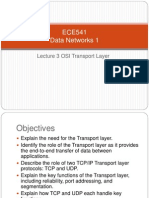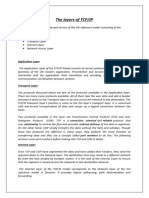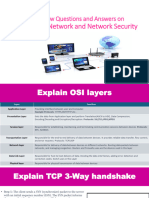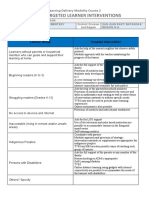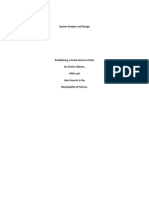0 ratings0% found this document useful (0 votes)
23 viewsTransport Layer Layer Presentation Layer: Session
Transport Layer Layer Presentation Layer: Session
Uploaded by
Kapil TanejaThe transport layer (layer 4) provides reliable data transmission and quality of service between applications on networked devices. It uses protocols like TCP, which establishes connections to reliably deliver segmented data in order, and UDP, which unreliably transmits datagrams without acknowledgment. The presentation layer (layer 6) prepares data for applications by performing tasks like data formatting, compression, and encryption so devices can understand the information exchanged.
Copyright:
Attribution Non-Commercial (BY-NC)
Available Formats
Download as PPT, PDF, TXT or read online from Scribd
Transport Layer Layer Presentation Layer: Session
Transport Layer Layer Presentation Layer: Session
Uploaded by
Kapil Taneja0 ratings0% found this document useful (0 votes)
23 views34 pagesThe transport layer (layer 4) provides reliable data transmission and quality of service between applications on networked devices. It uses protocols like TCP, which establishes connections to reliably deliver segmented data in order, and UDP, which unreliably transmits datagrams without acknowledgment. The presentation layer (layer 6) prepares data for applications by performing tasks like data formatting, compression, and encryption so devices can understand the information exchanged.
Original Title
n4
Copyright
© Attribution Non-Commercial (BY-NC)
Available Formats
PPT, PDF, TXT or read online from Scribd
Share this document
Did you find this document useful?
Is this content inappropriate?
The transport layer (layer 4) provides reliable data transmission and quality of service between applications on networked devices. It uses protocols like TCP, which establishes connections to reliably deliver segmented data in order, and UDP, which unreliably transmits datagrams without acknowledgment. The presentation layer (layer 6) prepares data for applications by performing tasks like data formatting, compression, and encryption so devices can understand the information exchanged.
Copyright:
Attribution Non-Commercial (BY-NC)
Available Formats
Download as PPT, PDF, TXT or read online from Scribd
Download as ppt, pdf, or txt
0 ratings0% found this document useful (0 votes)
23 views34 pagesTransport Layer Layer Presentation Layer: Session
Transport Layer Layer Presentation Layer: Session
Uploaded by
Kapil TanejaThe transport layer (layer 4) provides reliable data transmission and quality of service between applications on networked devices. It uses protocols like TCP, which establishes connections to reliably deliver segmented data in order, and UDP, which unreliably transmits datagrams without acknowledgment. The presentation layer (layer 6) prepares data for applications by performing tasks like data formatting, compression, and encryption so devices can understand the information exchanged.
Copyright:
Attribution Non-Commercial (BY-NC)
Available Formats
Download as PPT, PDF, TXT or read online from Scribd
Download as ppt, pdf, or txt
You are on page 1of 34
Transport Layer
Session Layer
Presentation Layer
By : Dr. poonam Garg
The Transport Layer
Layers 1 -3
Layer 1 allows bit streams to be created and to
travel.
Layer 2 packages those data packets into frames to
be converted to bit streams and makes LAN
delivery possible.
Layer three packages data from upper layers in
packets and makes routing and WAN delivery
possible.
Layer 4 - Transport Layer
But we have made no provision for
assuring our data reliably travels
end-to-end across the often vast network
path. Layer 4 performs multiple functions to
provide this "quality of service.”
Quality of Service
The phrase "quality of service" is often used
to describe the purpose of Layer 4 - the
transport layer. Its primary duties are to
transport and regulate the flow of
information from source to destination,
reliably and accurately.
repeat their words (reliability), and to speak slowly (flow
control).
The TCP/IP protocol of the OSI model Layer 4 (transport layer)
has two protocols - TCP and UDP.
TCP
TCP supplies a virtual circuit between end-user
applications. These are its characteristics:
connection-oriented
reliable
divides outgoing messages into segments
reassembles messages at the destination station
re-sends anything not received
reassembles messages from incoming segments.
UDP
UDP transports data unreliably between hosts. Following are
the characteristics of UDP:
connectionless
unreliable
transmit messages (called user datagrams)
provides no software checking for message delivery
(unreliable)
does not reassemble incoming messages
uses no acknowledgements
provides no flow control
TCP is connection-oriented and ensures reliability and
IP is connection-less with best effort attempts at delivery.
Transmission Control Protocol TCP.
Transmission Control Protocol (TCP) is a connection-
oriented Layer 4 (transport layer) protocol that provides
reliable full-duplex data transmission. TCP is part of the
TCP/IP protocol stack.
User Datagram Protocol (UDP)
UDP is the connectionless transport protocol in the
TCP/IP protocol stack. UDP is a simple protocol that
exchanges datagrams, without acknowledgments or
guaranteed delivery, requiring that error processing and
retransmission be handled by other protocols.
TCP Segment Fields
Following are the definitions of some of the fields in
the TCP segment:
source port -- number of the calling port
destination port -- number of the called port
sequence number -- number used to ensure correct sequencing
of the arriving data
acknowledgment number - next expected TCP octet
window -- number of octets that the sender is willing to accept
HLEN - number of 32-bit words in the header
reserved - set to zero
code bits - control functions (such as setup and termination of a
session)
checksum - calculated checksum of the header and data fields
urgent pointer - indicates the end of the urgent data
option- one option - maximum TCP segment size
data - upper-layer protocol data
UDP Segment Fields
UDP uses no windowing or acknowledgments, therefore application-layer
protocols provide reliability. UDP is designed for applications that do not need to
put sequences of segments together.
Protocols that use UDP include:
TFTP SNMP
DHCP
DNS (Domain Name System)
TCP & UDP Port Numbers
Both TCP and UDP use port (or socket)
numbers to pass information to the upper
layers.
Numbers below 255 - are for public
applications
Numbers from 255-1023 - are assigned to
companies for marketable applications
Numbers above 1023 - are unregulated
Common Public Port Number
3-Way Handshake
TCP hosts establish a connection-oriented session
with one another using a three-way handshake.
A three-way handshake synchronizes a connection
at both ends before user data is exchanged.
The exchange of introductory sequence numbers,
during the connection sequence, ensures that any data
that is lost, due to problems that may occur later, can
be recovered.
3-Way Handshake
Window Size
Window size determines the amount of data
that you can transmit at one time before
receiving an acknowledgment from the
destination.
Window Size = 3
Sequencing
TCP provides sequencing of segments with
a forward reference acknowledgment.
If a sequence number is missing in the
series, that segment is re-transmitted.
TCP Sequence &
Acknowledgement Number
The Session Layer
7 Application Network processes to applications
6 Presentation Data Representation
5 Session Interhost Communication
Establishes, manages and terminates
sessions between applications
4 Transport
3 Network
2 Data Link
1 Physical
Dialog Control
When the session layer decides whether to
use 2-way simultaneous or 2-way alternate
communication it is called dialogue control.
The session layer uses two major forms of
dialog control:
2-way alternate communication
2-way simultaneous communication
2-Way Alternate and 2-Way
Simultaneous Communication.
2-way alternate communication avoids
interrupts by taking turns.
2-way simultaneous communication allows
2 messages to cross during a conversation.
Dialogue Separation
Dialogue separation is the orderly initiation,
termination, and managing of
communication.
Layer 5 Protocols
Layer 6 - The Presentation Layer
The presentation layer is responsible for
presenting data in a form that the receiving
device can understand.
The presentation layer has 3 main functions:
data formatting
data compression
data encryption
Data Formatting
To understand how data formatting works,
imagine two dissimilar systems. The first system
uses Extended Binary Coded Decimal Interchange
Code (EBCDIC) to format text. The second
system uses American Standard Code for
Information Interchange (ASCII) to format text.
Layer 6 provides the translation between these two
different types of codes.
Graphic File Formats
The Internet uses two binary file formats to
display images:
Graphic Interchange Format (GIF)
Joint Photographic Experts Group (JPEG).
Any computer with a reader for the GIF and
JPEG file formats can read these file types,
regardless of the type of computer.
Multimedia File Format
The multimedia file format is another type
of binary file, which stores sounds, music,
and video.
Sound files may be completely downloaded,
first, and then played, or they may download
while they are playing. The latter method is
referred to as streaming audio.
Markup Language
Another type of file format is markup
language. This format acts as a set of
directions that tell a Web browser how to
display and manage documents. Hypertext
Markup Language (HTML) is the language
of the Internet.
Encryption & Compression
Layer 6 is responsible for data encryption.
Data encryption protects information during
its transmission.
The presentation layer is also responsible
for the compression of files.
You might also like
- Lacoste R., Edgeworth B. - CCNP Enterprise Advanced Routing ENARSI 300-410 Official Cert Guide (2020) PDFDocument1,883 pagesLacoste R., Edgeworth B. - CCNP Enterprise Advanced Routing ENARSI 300-410 Official Cert Guide (2020) PDFSrishti Baliyan65% (26)
- Video MarketingDocument33 pagesVideo MarketingNishantNo ratings yet
- Chapter TwoDocument71 pagesChapter TwoyaNo ratings yet
- Day Three BNFDocument13 pagesDay Three BNFThet Wai LwinNo ratings yet
- Presentation Osi RMDocument39 pagesPresentation Osi RMNavneetNo ratings yet
- ECE541 Data Networks 1: Lecture 3 OSI Transport LayerDocument36 pagesECE541 Data Networks 1: Lecture 3 OSI Transport LayerUnicorn54No ratings yet
- CCNA Network Fundamentals - CH4Document37 pagesCCNA Network Fundamentals - CH4Lucelle MoralesNo ratings yet
- Network Protocol ArchitecturesDocument17 pagesNetwork Protocol Architecturesamash.emillyNo ratings yet
- Computer Networks Notes Unit 3Document41 pagesComputer Networks Notes Unit 3its4alok6332No ratings yet
- Osi Model NotesDocument7 pagesOsi Model NotesSuman KumarNo ratings yet
- CN InternalDocument9 pagesCN InternalrudyvampxNo ratings yet
- Role of The Transport Layer: Tracking Individual ConversationsDocument5 pagesRole of The Transport Layer: Tracking Individual ConversationsAnonymous vWJXWUNo ratings yet
- Notes On Computer Networks Unit4Document12 pagesNotes On Computer Networks Unit4Rohit Chaudhary67% (3)
- The Layers of TCPDocument2 pagesThe Layers of TCPNaveen RecizNo ratings yet
- Tcp/Ip: How The TCP/IP Protocol Stack Maps To The OSI Model OSI Layers TCP/IP ProtocolsDocument5 pagesTcp/Ip: How The TCP/IP Protocol Stack Maps To The OSI Model OSI Layers TCP/IP Protocolsajithcoumar351No ratings yet
- Edited Unit 4 CN 4TH SemDocument8 pagesEdited Unit 4 CN 4TH Sempawanchourasia0329No ratings yet
- ProtocolsDocument22 pagesProtocolssharkapproachNo ratings yet
- Unit VDocument33 pagesUnit VErwin VunguNo ratings yet
- Internetworking ModelsDocument4 pagesInternetworking ModelsDip KunduNo ratings yet
- Network ModelsDocument41 pagesNetwork ModelsAruNo ratings yet
- Application LayerDocument12 pagesApplication LayerJunjun BedrijoNo ratings yet
- Ass 1 VygygyDocument11 pagesAss 1 Vygygyshamim20517No ratings yet
- Unit Iv-1Document33 pagesUnit Iv-1InnocentNo ratings yet
- Net 102 Prelim ModulesDocument36 pagesNet 102 Prelim ModulesNovy Airhris MianaNo ratings yet
- Transmission Control Protocol (TCP) / Internet Protocol (Ip)Document24 pagesTransmission Control Protocol (TCP) / Internet Protocol (Ip)Harshitha BaranikaNo ratings yet
- Final Assignment Computer NetworksDocument12 pagesFinal Assignment Computer NetworksMasood MughalNo ratings yet
- CIR 209 (Lecture 4e) OSI - ModelDocument9 pagesCIR 209 (Lecture 4e) OSI - Modeldancanongori9No ratings yet
- CN ImpDocument32 pagesCN Impblkhackr1jNo ratings yet
- Module 7 OSI AND TCP IP MODELSDocument14 pagesModule 7 OSI AND TCP IP MODELSlemonademagnumNo ratings yet
- Week 2Document146 pagesWeek 2gojan39660No ratings yet
- CN UNIT-IIIDocument17 pagesCN UNIT-IIIHari MNo ratings yet
- Chapeter 2Document42 pagesChapeter 2Ravindra SinghNo ratings yet
- CN Unit 5 Computer Network NotesDocument33 pagesCN Unit 5 Computer Network Notesgdsc.pragatiNo ratings yet
- CN Book 2017-3-11Document9 pagesCN Book 2017-3-11mspriyarcNo ratings yet
- PrinterFriendlyViewPack - PHP PackId 170516Document24 pagesPrinterFriendlyViewPack - PHP PackId 170516Frederick Albert SkettiniNo ratings yet
- DCCN Notes Unit1Document61 pagesDCCN Notes Unit1pratheepku32No ratings yet
- Network Viva Questions and AnswersDocument29 pagesNetwork Viva Questions and AnswersAditya HebbarNo ratings yet
- Chapter 2Document14 pagesChapter 2SANKET BITODENo ratings yet
- Data and Computer Communications: Tenth Edition by William StallingsDocument44 pagesData and Computer Communications: Tenth Edition by William StallingsAlexa RobinsNo ratings yet
- CN Unit - 4Document40 pagesCN Unit - 421WH1A6642 KUKKAPALLY PRAHARSHITHANo ratings yet
- Lecture 5Document11 pagesLecture 5Rylan2911No ratings yet
- Capture All HTTP Packets by Using Wireshark and Try To Fetch All HTTP Usernames & PasswordsDocument38 pagesCapture All HTTP Packets by Using Wireshark and Try To Fetch All HTTP Usernames & PasswordsCandy AngelNo ratings yet
- Transport-Layer-And-ProtocolsDocument9 pagesTransport-Layer-And-ProtocolsMuhammad Taha RasoulNo ratings yet
- UNIT 4 ACN UpdatedDocument68 pagesUNIT 4 ACN UpdatedagasyabutoliaNo ratings yet
- 4 Understanding TCP IP Protocol Suite ScriptDocument6 pages4 Understanding TCP IP Protocol Suite ScriptJeetNo ratings yet
- SOC2Document20 pagesSOC2The AnonymousNo ratings yet
- Communication in Distributed SystemsDocument20 pagesCommunication in Distributed Systemslucyngei2021No ratings yet
- CN-Unit-1 - Part2 NotesDocument9 pagesCN-Unit-1 - Part2 NotesMeghnadhNo ratings yet
- Communications Layers SummaryDocument7 pagesCommunications Layers SummaryKarthickmanikandan GNo ratings yet
- Week 3: Lecturer: Saleem Al - ZoubiDocument60 pagesWeek 3: Lecturer: Saleem Al - ZoubiTejaswini SkumarNo ratings yet
- Used To Manage and Monitor The NetworkDocument35 pagesUsed To Manage and Monitor The NetworkFikru TesefayeNo ratings yet
- Reference ModelsDocument24 pagesReference ModelsHope MikhelsonNo ratings yet
- Unit-5 Transport and Upper Layers in OSI ModelDocument7 pagesUnit-5 Transport and Upper Layers in OSI Modelbobbysingh727272No ratings yet
- Layer OSIDocument3 pagesLayer OSIClarence Joy BautistaNo ratings yet
- What Are The 7 Layers of OSI MODELDocument3 pagesWhat Are The 7 Layers of OSI MODELZheny Jennel MasagaNo ratings yet
- Osi and Tcp/Ip Model: DR - Tanuja S.DhopeDocument36 pagesOsi and Tcp/Ip Model: DR - Tanuja S.DhopeAnmol PatilNo ratings yet
- Network Handout PDFDocument91 pagesNetwork Handout PDFShivam SinghNo ratings yet
- CCNA Interview Questions and Answers Guide-24Document31 pagesCCNA Interview Questions and Answers Guide-24R Adil waheedNo ratings yet
- Lecture 2Document8 pagesLecture 2jasmhmyd205No ratings yet
- Network Models: Ambo University Woliso Campus Technology and Informatics School Department of Computer ScienceDocument73 pagesNetwork Models: Ambo University Woliso Campus Technology and Informatics School Department of Computer ScienceNoel GirmaNo ratings yet
- CN Unit4 NDocument30 pagesCN Unit4 NsaeuhsaoteuNo ratings yet
- Hacking Network Protocols: Unlocking the Secrets of Network Protocol AnalysisFrom EverandHacking Network Protocols: Unlocking the Secrets of Network Protocol AnalysisNo ratings yet
- Tecmpl 3201Document289 pagesTecmpl 3201acmilan12031984No ratings yet
- List of Targeted Learner Interventions: Learning Delivery Modality Course 2Document1 pageList of Targeted Learner Interventions: Learning Delivery Modality Course 2Ai Leen Anaz Nam100% (1)
- Digital Marketing A Review PDFDocument5 pagesDigital Marketing A Review PDFcasaNo ratings yet
- System Analysis and DesignDocument19 pagesSystem Analysis and DesignPaolo TenorioNo ratings yet
- Unit 7Document41 pagesUnit 7harshvikadia08No ratings yet
- The Key Elements To Develop Mobile Applications For A Higher Educational Environment: Empirical StudyDocument19 pagesThe Key Elements To Develop Mobile Applications For A Higher Educational Environment: Empirical Studymoh benNo ratings yet
- Session 5a. ICT Development Index PDFDocument24 pagesSession 5a. ICT Development Index PDFErijNo ratings yet
- PestleDocument11 pagesPestlebobmufc08No ratings yet
- Worksheet - GroupsDocument50 pagesWorksheet - GroupsSilas SuryawijayaNo ratings yet
- 03 Max-Ng Overview CoreDocument26 pages03 Max-Ng Overview CoreLavanya MummadiNo ratings yet
- 12 22desmond 1Document12 pages12 22desmond 1Antonio BrtanNo ratings yet
- Whatisarestapi?: Api: Application Programming InterfaceDocument3 pagesWhatisarestapi?: Api: Application Programming InterfaceYesmine MakkesNo ratings yet
- University of Cape Town Department of Computer Science CSC3002F Class Test 1 March 2018Document55 pagesUniversity of Cape Town Department of Computer Science CSC3002F Class Test 1 March 2018Lethabo MoropaNo ratings yet
- Changes in The Integration of Art and Copy From 1960 To PresentDocument53 pagesChanges in The Integration of Art and Copy From 1960 To PresentAddison BornNo ratings yet
- State of Publishing Now (1pg)Document1 pageState of Publishing Now (1pg)Somersault Group50% (2)
- Yahoo?: Business On Internet Time: by Girotte and RivkinDocument17 pagesYahoo?: Business On Internet Time: by Girotte and RivkinclevinnashNo ratings yet
- What Is Disposable Temporary E-Mail?: Your Temporary Email AddressDocument2 pagesWhat Is Disposable Temporary E-Mail?: Your Temporary Email AddressDavidNo ratings yet
- BRM AssignmentDocument7 pagesBRM AssignmentAmar HegdeNo ratings yet
- Suraj Thakur Phone: - +91 8285214145, +918383026276 Current Location: Noida (INDIA) Career ObjectiveDocument4 pagesSuraj Thakur Phone: - +91 8285214145, +918383026276 Current Location: Noida (INDIA) Career Objectivevaishnavi thakurNo ratings yet
- Deloitte Cloud - Task 1 - Understanding Cloud Computing - TemplateDocument3 pagesDeloitte Cloud - Task 1 - Understanding Cloud Computing - TemplateApurbh Singh KashyapNo ratings yet
- EasyOutsource Audit - PresentationDocument26 pagesEasyOutsource Audit - Presentationwing.jamesofaminNo ratings yet
- Scifinder User Registration: UsernameDocument4 pagesScifinder User Registration: UsernamePilar CaleroNo ratings yet
- Sim7022 Spec en 20221020Document2 pagesSim7022 Spec en 20221020Spider hate bugsNo ratings yet
- Multilingualism Workshop Dawit BekeleDocument10 pagesMultilingualism Workshop Dawit BekeleSivasubramanian MuthusamyNo ratings yet
- 09hakin9 09 2012 EN EbookDocument49 pages09hakin9 09 2012 EN EbookcristianorpjNo ratings yet
- Arp Lab Skill2 CDP NTP HSRP STP Etherchannel 20171020Document1 pageArp Lab Skill2 CDP NTP HSRP STP Etherchannel 20171020Elias EstebanNo ratings yet
- Introduction To Ethical Hacking PDFDocument14 pagesIntroduction To Ethical Hacking PDFDodik Krisd50% (2)
- Project On E Commerce Applications by Shikha 2028100866 MBA-2Document43 pagesProject On E Commerce Applications by Shikha 2028100866 MBA-2Ashok poddarNo ratings yet





